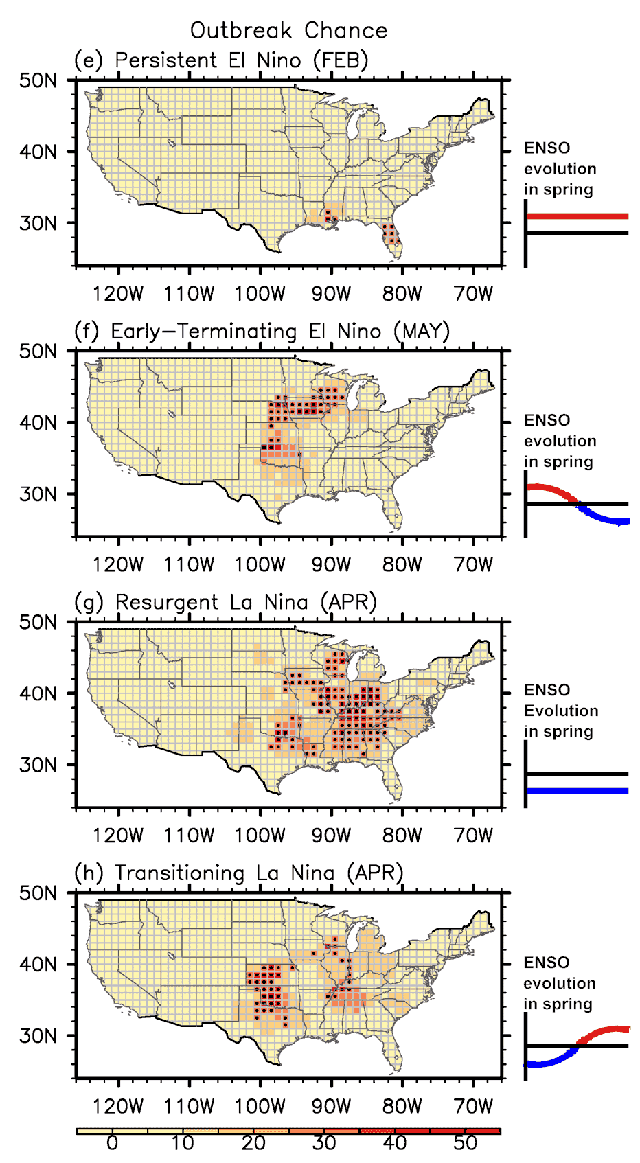April 13th, 2016
Key Findings
- Historical U.S. regional tornado outbreaks are linked to sea surface temperature (SST) variations due to the El Niño / Southern Oscillation (ENSO) and the North Atlantic tripole mode. These SST signals induce atmospheric conditions conducive to U.S. outbreaks, such as increased wind shear and the convergence of warm moist air originating from the Gulf of Mexico.
- El Niño events that persist into boreal spring, such as the 2015-16 event, are associated with a relatively mild risk of tornado outbreaks over most of the country, except along the Gulf Coast and central Florida in February. In contrast, weak early-terminating El Niño events tend to boost the likelihood of tornado outbreaks in the Upper Midwest by up to 50% in May.
- La Niña events that resurge in boreal spring tend to enhance the likelihood of tornado outbreaks over widespread regions of the Ohio Valley, Southeast, and Upper Midwest by up to 57% in April. In contrast, a La Niña transitioning to El Niño in boreal spring boosts the likelihood of tornado outbreaks in the South, particularly Kansas and Oklahoma, by up to 50% in April.
- Despite these connections, there remains a large element of chance: tornado outbreaks can occur in any season and almost anywhere in the U.S., regardless of the state of ENSO.
S.-K. Lee, A. T. Wittenberg, D. B. Enfield, S. J. Weaver, C. Wang, and R. M. Atlas. Environmental Research Letters. DOI:10.1088/1748-9326/11/4/044008
Summary
Tornado outbreaks are one of nature’s most destructive forces. This study breaks new ground on a potential basis for seasonal predictability of tornado outbreak probability over the U.S. in boreal spring. The goal of the study was to explore the scientific basis for predictions of outbreaks a month or more in advance. Currently, the risk of regional tornado outbreaks is predictable only about a week ahead.
The authors linked historical U.S. regional tornado outbreaks to sea surface temperature variations due to the El Niño / Southern Oscillation and the North Atlantic tripole mode. These sea surface temperature signals induce atmospheric conditions conducive to U.S. outbreaks, such as increased wind shear and the convergence of warm moist air originating from the Gulf of Mexico.
This research revealed that El Niño events that persist into boreal spring, such as in 2015-16, are associated with a relatively mild risk of tornado outbreaks over most of the country, except along the Gulf Coast and central Florida in February. In contrast, weak early-terminating El Niño events tend to boost the likelihood of tornado outbreaks in the Upper Midwest by up to 50% in May.
La Niña events that resurge in boreal spring tend to enhance the likelihood of tornado outbreaks in April, over widespread regions of the Ohio Valley, Southeast, and Upper Midwest by up to 57%. In contrast, a La Niña transitioning to El Niño in boreal spring boosts the likelihood of tornado outbreaks in the South, particularly Kansas and Oklahoma, by up to 50% in April. Despite these connections, tornado outbreaks can occur in any season and almost anywhere in the U.S., regardless of the state of ENSO.
To conduct this research, the authors examined historical weather and climate records for the period 1950-2014. An “outbreak month” is defined as when at least 12 weighted F1-F5 tornadoes occur within a 200 km radius of a given point over 5 consecutive days within the month (the weighting assigns an F1 tornado a 1, F5 a 5). The probability of outbreak in a given month, and the statistical significance of that probability, are then linked to global sea surface temperature variations — including the previously-identified main spatiotemporal “flavors” of ENSO (persistent El Niño, early-terminating El Niño, resurgent La Niña, and transitioning La Niña).
Future work is aimed at incorporating ENSO and other climate patterns into statistical and dynamical models, with the goal of reliably forecasting the likelihood of U.S. tornado outbreaks one to three months in advance.
Click here for a video summary.



